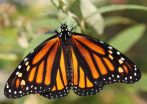(Press-News.org) PROSSER, Wash. - Washington wine grape vineyards experimenting with sustainable pest management systems are seeing an unexpected benefit: an increase in butterflies.
Over the years, loss in natural habitat has seen the decline in numbers of around 50 species of butterflies in eastern Washington. But in a recent Washington State University study published in the June issue of the Journal of Insect Conservation, researchers found that vineyards that create nearby natural habitats have three times the number of butterfly species and four times more butterflies than conventional vineyards.
WSU researchers recorded 29 separate species in "habitat-enhanced" vineyards, compared to nine species in conventional vineyards. In terms of raw numbers, they counted on average 20 butterflies in habitat-enhanced vineyards compared to five in conventional areas.
A fluttery side effect
David James, an associate professor in WSU's Department of Entomology, wrote the paper with colleagues. He said butterfly increase was not the goal of the return of natural habitats. Instead, growers want to reduce pesticide usage.
To help control pests, they plant native sage-steppe shrubbery in and around their vineyards. These native plants, such as desert buckwheat shrubs, attract "good" insects like parasitic wasps, James said.
Wasps feed on mealybugs and other "bad" insects that can be harmful to the vineyards. But as a side benefit, these vineyards are seeing the return of other inhabitants that had declined when natural habitat was removed.
"Conservation of butterflies is becoming an issue because all species are declining," James said. "The habitat has been taken away by agriculture. This is a way of giving back. We're showing that an agricultural industry can live alongside the natural ecology and help preserve and conserve it."
This method of conservation may be exclusive to Washington, since vineyards in this state already face fewer pests and use fewer chemicals than vineyards in states like California.
"We're fortunate here to have the perfect place to be able to have this sustainable option," James said.
Why butterflies?
The increase in butterfly numbers isn't directly beneficial to vineyards. Butterflies don't eat any pests or have any direct economic benefit. But they naturally live on the returned native plants, both as caterpillars and as adult butterflies. They also have immense aesthetic appeal to people, are important pollinators and are an important part of healthy ecosystems.
James said the viticulture industry is unusual in agriculture because many vineyards and wineries invite people onto the property to enjoy the product.
"To have butterflies flying around could be part of a tourism drive and an attraction for visitors," he said. "In these days of organic production and not wanting pesticides on food, butterflies can be a symbol of that. To show butterflies flying around vineyards has great aesthetic and commercial appeal."
Career coming full circle
James has been working on pest management in grapes and other crops for several decades. But his interest in entomology started with butterflies. He's written a few books on butterflies, including "Life Histories of Cascadia Butterflies" about species that live in Washington. But he's rarely been able to study them professionally because they don't have a large economic impact.
"It's very rare to get a job that involves butterflies. They weren't even under threat when I started my career," said James, who wrote his Ph.D. dissertation 30 years ago on about the monarch butterfly. "But to now combine practical pest management work with butterflies is remarkable. And I think it will only grow as we continue to see the benefits of natural pest management around the world. Nature conservation and agriculture will be intimately linked in the future. The Washington wine grape industry is a pioneer of this movement."
INFORMATION:
In what marks a significant step forward for artificial intelligence, researchers at UC Santa Barbara have demonstrated the functionality of a simple artificial neural circuit. For the first time, a circuit of about 100 artificial synapses was proved to perform a simple version of a typical human task: image classification.
"It's a small, but important step," said Dmitri Strukov, a professor of electrical and computer engineering. With time and further progress, the circuitry may eventually be expanded and scaled to approach something like the human brain's, which has ...
TORONTO (May 11, 2015) -- Immigrants from the Caribbean and Bermuda, as well as refugees from East Africa and South Asia, have a 1.5 to 2 times higher risk of psychotic disorders compared to the general population of Ontario, Canada, according to a new study by researchers at the Institute for Clinical Evaluative Sciences (ICES) and the Centre for Addiction and Mental Health (CAMH). The study also found that immigrants from Northern Europe, Southern Europe and East Asia had about half the risk of psychotic disorders compared to the general population.
The study published ...
By combining 3D holographic lithography and 2D photolithography, researchers from the University of Illinois at Urbana-Champaign have demonstrated a high-performance 3D microbattery suitable for large-scale on-chip integration with microelectronic devices.
"This 3D microbattery has exceptional performance and scalability, and we think it will be of importance for many applications," explained Paul Braun, a professor of materials science and engineering at Illinois. "Micro-scale devices typically utilize power supplied off-chip because of difficulties in miniaturizing ...
U.S. Congress approval ratings are at record lows. Now a new study suggests that this may be partly due to a decline in the use of warm, agreeable language in the House.
The study, co-authored by University of British Columbia business professor Karl Aquino, found that the use of prosocial words -- language such as cooperate or contribute -- by lawmakers predicts public approval of Congress six months later.
"If members of Congress want to be viewed more positively by the public, it appears that the words they use matter," says Aquino, a marketing and behavioural science ...
Researchers report that as the world population increases and food demand has grown, globalization of trade has made the food supply more sensitive to environmental and market fluctuations. This leads to greater chances of food crises, particularly in nations where land and water resources are scarce and therefore food security strongly relies on imports.
The study assesses the food supply available to more than 140 nations (with populations greater than 1 million) and demonstrates that food security is becoming increasingly susceptible to perturbations in demographic ...
(MEMPHIS, Tenn. - May 11, 2015) Childhood cancer survivors - especially those whose treatment included brain irradiation or chemotherapy with glucocorticoids - are 14 percent more likely to be obese than their healthy peers. The St. Jude Children's Research Hospital study appears today in the journal Cancer.
Of the 1,996 childhood cancer survivors in this study, 36.2 percent had a body mass index (BMI) of 30 kilograms per meters squared or more, which qualifies as obese. That was 14 percent greater than the expected prevalence based on federal health survey data of a ...
(MEMPHIS, Tenn. - May 11, 2015) Researchers have identified three genes that play a pivotal role in the brain tumor choroid plexus carcinoma (CPC), a discovery that lays the groundwork for more effective treatment of this rare, often fatal cancer. St. Jude Children's Research Hospital scientists led the study, which appears today in the journal Cancer Cell.
The genes - TAF12, NFYC and RAD54L - are involved in DNA repair and regulation. Researchers showed that CPC often has at least one extra copy of each gene and demonstrated that the genes work cooperatively to launch ...
A new study finds that men with prostate cancer that has spread to nearby lymph nodes, who have a significant risk of dying from the disease, can benefit from the addition of radiation therapy to treatments that block the effects of testosterone. The findings imply that the almost half of patients with node-positive disease nationwide who this study found had not received combination therapy were not receiving the treatment that could best control their tumor and possibly save their lives. The report from investigators at the Massachusetts General Hospital (MGH) Cancer ...
EAST LANSING, Mich. - When it comes to winning evolutionary fitness races, the tortoise once again prevails over the hare.
In the current issue of Proceedings of the National Academy of Sciences, a team of BEACON scientists centered at Michigan State University found that limiting migrations among populations of bacteria produced better adaptations.
The cost, however, was that the bacteria evolved slower. Taking your time, however, isn't always a bad thing, said Joshua Nahum, MSU biocomputational research associate.
"We name this the Tortoise-Hare pattern, as it is ...
Achieving sustainability requires a sophisticated understanding of continuously evolving resource, production, and consumption systems that make up society's relationship to nature. In a special new issue, Yale's Journal of Industrial Ecology illustrates how the field is increasingly turning to complexity science for tools and insights in its pursuit of reduced environmental impacts.
In the special issue, "Advances in Complex Adaptive Systems and Industrial Ecology," a group of international researchers show how integration of complex adaptive system into the study of ...





